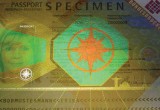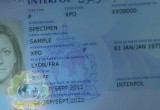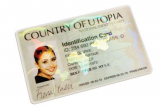Hologram dust adds fingerprint to secure ID documents
New document security feature authenticates individual passports and cards
06 March, 2017
category: Corporate, Government
Secure hologram leader, OPTAGLIO, is using holographic “digital dust” not just deter document fraud but to uniquely identify individual documents from an issuer. Think of it this way: using the technology, each passport, card or secure ID document can have a unique fingerprint that lets the document itself be authenticated.
The company has several new negotiated contracts to incorporate the patented new product, OPTAGLIO OVImage. It both protects against counterfeiting and also enables the identification of a particular document, even if that document has been tampered with or altered.
Security holograms are among strongest anti-counterfeiting mechanisms and duplication of advanced security holograms is extremely difficult. However, holograms are identical — mass produced using the same master — so there has been no application of the technology for identifying particular, individual documents.
OPTAGLIO researchers, however, found that by scattering extremely small particles containing hologram within a document and mapping the location and orientation of those particles, a unique pattern or fingerprint could be built. The metallic particles are each of regular shape – a la pentagons – and each has a holographic surface.
They call the particles microholograms, and when viewed by the naked eye, they look like metallic dust. Under higher resolution, however, a complete hologram can be found on each particle and a pattern emerges.

New document security feature from OPTAGIO uses holographic ‘dust’ to create unique biometric patterns for secure ID documents
The OVImage product is based on random scattering of microholograms into a defined area of secure ID document such as a card, passport, banknote, visa or tax stamp. The particles are hot stamped on paper or sealed into plastic. At the point of document personalization or issuance, the unique pattern on a particular secure ID document is recorded and stored to enable future identification of the document.
“Once a document has been created, even we in OPTAGLIO cannot imitate it,” explains Igor Jermolajev, the research manager in OPTAGLIO. He explains that anti-counterfeit protections are normally based on reliable recognition of a protective element, but OVImage goes even further.
“You can exactly identify from what passport the abused element was removed,” he adds. “You can say when the passport was issued, who was its holder, if its stealing was correctly reported etc.”
Personal documents have serial numbers but the falsifiers can tamper them. Identification based on an element that cannot be imitated brings improvement in protection and forensic identification. The improvement is critical because criminals and terrorist groups often target weak points in secure ID document protection.
“Security issues prevent us from announcing particular clients and contracts but several countries will be able to identify particular documents in the near future,” he says.




